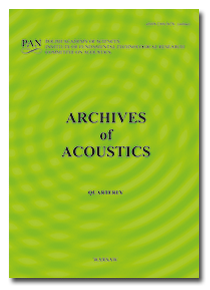Archives of Acoustics,
37, 4, pp. 561–569, 2012
Pressure Level Standard Deviation at Low Frecuencies: Effect of the Wall Vibrational Field
Knowledge of the uncertainty of measurement of testing results is important when results have to be
compared with limits and specifications. In the measurement of sound insulation following standards ISO
140-4 and 140-5 the uncertainty of the final magnitude is mainly associated to the average sound pressure
levels L1 and L2 measured. However, the study of sound fields in enclosed spaces is very difficult: there
are a wide variety of rooms with different sound fields depending on factors as volume, geometry and
materials. A parameter what allows us to quantify the spatial variation of the sound pressure level is the
standard deviation of the pressure levels measured at the different positions of the room. Based on the
analysis of this parameter some results have been pointed out: we show examples on the influence of the
microphone positions and the wall characteristics on the uncertainty of the final magnitudes mainly at
the low frequencies regime. In this line, we propose a theoretical calculus of the standard deviation as a
combined uncertainty of the standard deviation already proposed in the literature focused in the room
geometry and the standard deviation associated to the wall vibrational field.
compared with limits and specifications. In the measurement of sound insulation following standards ISO
140-4 and 140-5 the uncertainty of the final magnitude is mainly associated to the average sound pressure
levels L1 and L2 measured. However, the study of sound fields in enclosed spaces is very difficult: there
are a wide variety of rooms with different sound fields depending on factors as volume, geometry and
materials. A parameter what allows us to quantify the spatial variation of the sound pressure level is the
standard deviation of the pressure levels measured at the different positions of the room. Based on the
analysis of this parameter some results have been pointed out: we show examples on the influence of the
microphone positions and the wall characteristics on the uncertainty of the final magnitudes mainly at
the low frequencies regime. In this line, we propose a theoretical calculus of the standard deviation as a
combined uncertainty of the standard deviation already proposed in the literature focused in the room
geometry and the standard deviation associated to the wall vibrational field.
Keywords:
building acoustic; uncertainty
Full Text:
PDF
Copyright © Polish Academy of Sciences & Institute of Fundamental Technological Research (IPPT PAN).





